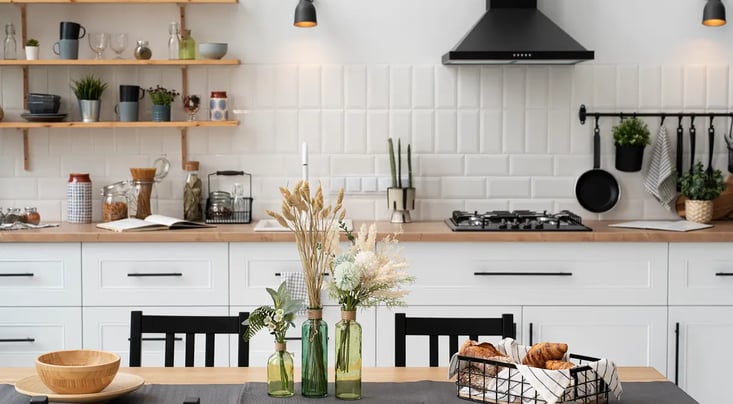
How to Transform Your Kitchen: Layout for Seamless Cooking
Learn how to boost kitchen efficiency with simple tips on organization, meal prep, and smart tools to save time and stress.
FOOD PREPARATION
Mae Ellison
2/24/20255 min read


How to Maximize Kitchen Efficiency
Maximizing kitchen efficiency isn’t just about having the latest gadgets or fancy countertops; it’s about creating an environment that allows you to work smarter, not harder. Whether you're preparing quick meals on weekdays or cooking elaborate dinners on weekends, an efficient kitchen can save you time, reduce stress, and even make cooking more enjoyable.
In this guide, we'll walk you through simple yet powerful ways to boost your kitchen’s efficiency, from organizing your pantry to optimizing your layout and using smart appliances. If you’re ready to streamline your cooking space, read on for actionable tips that can make a big difference.
1. Understanding Kitchen Efficiency
What Does Kitchen Efficiency Mean?
Kitchen efficiency refers to how well you use your time, space, and resources while cooking. It’s about reducing the amount of time spent looking for ingredients, minimizing clutter, and streamlining your cooking process. By optimizing your kitchen layout and organization, you can create a functional cooking space that allows you to focus on what matters most—preparing great meals.
Key Principles of an Efficient Kitchen
An efficient kitchen is a well-organized kitchen. Start by simplifying tasks, organizing tools, and creating a smooth workflow. Here are the principles that should guide your kitchen organization:
Declutter your space: The fewer distractions, the better. A clean, organized kitchen allows you to focus on cooking without wasting time looking for tools or ingredients.
Create a logical flow: Keep everything you need within reach, reducing unnecessary steps. This includes organizing your prep, cooking, and cleaning areas.
Maximize storage: Use cabinets, drawers, and shelves effectively to store tools and ingredients.
The Role of Kitchen Design in Efficiency
Your kitchen layout plays a key role in how efficiently you can work in the space. A good layout minimizes unnecessary movement, so you can easily access what you need. The "work triangle" (the ideal arrangement of your stove, sink, and fridge) is a foundational design principle for maximizing efficiency.
2. Smart Kitchen Organization Techniques
Decluttering Your Kitchen
A cluttered kitchen can make meal prep feel like an overwhelming task. Start by removing unnecessary items and organizing the tools you use most frequently. Here’s how to declutter:
Purge unused items: Go through your drawers and cabinets and get rid of items you no longer use. Keeping only the essentials frees up space and makes it easier to access what you need.
Maximize counter space: Only leave out essential items like a cutting board and a knife block. Store other gadgets in drawers or cabinets to keep your countertops clear.
Utilize vertical storage: Install shelves or use hanging racks to store pots, pans, and utensils to free up valuable counter space.
Effective Kitchen Storage Solutions
Make the most of every corner of your kitchen with clever storage solutions. Here are some tips:
Use clear containers: Store pantry items in transparent, labeled containers so you can quickly identify what you need without rummaging through cupboards.
Drawer organizers: Use dividers to separate utensils, tools, and small appliances. This helps to keep everything in its place and saves time when searching for items.
Under-counter storage: Invest in pull-out cabinets or under-shelf baskets to make the most of your kitchen’s lower cabinets.
Optimizing Pantry Organization
An organized pantry saves you time and effort when preparing meals. Here's how to make it work:
Group similar items: Group ingredients like canned goods, grains, and snacks together. This helps you quickly locate what you're looking for.
Label everything: Label jars and containers with both the contents and expiration dates to avoid confusion.
Store in accessible spots: Place frequently used items at the front of shelves, and less-used items toward the back to reduce the time spent searching.
3. Time-Saving Tips for Better Cooking
Meal Prep Strategies
Meal prepping is one of the most effective ways to reduce cooking time during the week. By spending a few hours preparing ingredients and meals in advance, you can save valuable time on busy days.
Prep ingredients in bulk: Chop vegetables, marinate proteins, or cook grains and starches in advance. Keep them in airtight containers for easy use throughout the week.
Batch cooking: Cook large portions of meals like soups, stews, and casseroles that can be stored and reheated for multiple meals.
Pre-portion meals: Use meal prep containers to portion out individual servings of each meal, making it easy to grab and go when you’re in a rush.
Task-Specific Tools for Efficiency
Having the right kitchen tools can dramatically speed up your cooking process. Some essential time-saving tools include:
Food processors: Chop, slice, shred, and puree ingredients quickly with a food processor, reducing prep time.
Instant Pot or multi-cookers: These appliances help you cook meals in a fraction of the time compared to traditional methods.
Blenders: Blend sauces, soups, and smoothies in seconds, cutting down on cooking time.
Air fryers: Cook crispy dishes with less oil and in less time than traditional frying.
Cooking Hacks to Maximize Efficiency
Beyond tools, there are several smart cooking techniques that can make your time in the kitchen more efficient:
Multi-task while cooking: Start prepping while you’re cooking to save time. For example, chop vegetables or prepare a side dish while the main course cooks.
Use fewer pots and pans: Choose one-pot or sheet pan recipes to reduce cleanup time and simplify the cooking process.
Batch cook: Prepare larger quantities of food to save time on cooking during the week.
4. Maximizing Kitchen Workflow and Productivity
Creating a Functional Cooking Station
Your kitchen should have clearly defined workstations to ensure everything is within reach and organized. Here’s how to create the perfect cooking station:
Prep station: Keep a cutting board, knives, and bowls near the sink and stove to easily prepare ingredients.
Cooking station: Ensure your stovetop and oven are within easy reach of your prep station. This minimizes the back-and-forth motion between areas.
Cleaning station: Keep your sink and dish rack organized so that you can quickly clean up as you go.
Optimizing Your Kitchen Layout
Your kitchen layout can impact how efficiently you cook. Here’s how to optimize it:
Work triangle: Keep the sink, stove, and refrigerator in a triangular layout to minimize unnecessary steps while cooking.
Task zones: Define specific areas for different tasks, like food prep, cooking, and cleaning. This ensures you can easily transition from one step to the next without wasting time.
Consider traffic flow: Ensure that your kitchen allows for easy movement between tasks without congestion or obstacles.
Smart Kitchen Appliances
Investing in the right appliances can make a huge difference in your cooking efficiency. Here are some to consider:
Induction cooktops: They heat up quickly and provide precise temperature control, speeding up cooking times.
Sous-vide cooking: Precision cooking with sous-vide machines makes it easier to cook food to the perfect temperature with minimal effort.
Dishwashers: A dishwasher saves you time on cleanup, allowing you to focus on cooking instead of scrubbing pots and pans.
5. Sustainable Practices for an Efficient Kitchen
Reducing Food Waste
Reducing food waste not only benefits the environment but also maximizes kitchen efficiency. Here’s how:
Get creative with leftovers: Transform them into new meals to minimize waste. For example, use leftover chicken for sandwiches, salads, or soups.
Smart storage: Store perishable foods like fruits and vegetables in the right conditions to prolong their shelf life.
Composting: Compost food scraps like vegetable peels and coffee grounds to reduce waste and enrich your garden.
Sustainable Kitchen Gadgets
Investing in eco-friendly gadgets can help you maximize efficiency while being kind to the planet. Look for:
Energy-efficient appliances: Induction cooktops and slow cookers use less energy than traditional gas or electric stoves.
Reusable kitchen products: Swap out disposable paper towels for washable cloths and use reusable wraps instead of plastic wrap.
Eco-Friendly Cooking Techniques
Being efficient in the kitchen also means minimizing energy usage. Here are some tips:
Pressure cooking: Use pressure cookers or slow cookers to reduce cooking time and energy consumption.
Air frying: An air fryer uses significantly less oil and energy than traditional frying methods.
Cook with seasonal ingredients: Buy fresh, local ingredients that require less energy to produce and transport.
Conclusion
By implementing these strategies, you’ll not only maximize your kitchen efficiency but also save time, reduce stress, and create a more enjoyable cooking environment. Whether it's through organizing your pantry, using smart gadgets, or planning meals in advance, small changes can make a significant impact. Take the first step today to turn your kitchen into an organized, productive space that helps you cook better, faster, and more efficiently!
